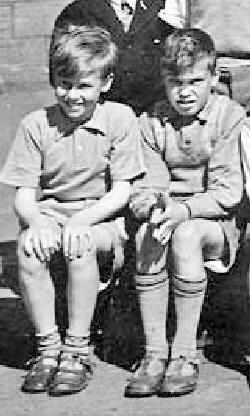
Figure 1.--Here we see two primary boys in the 1950s. The both wear sandals. One boy wears the double-strap style while the other boy wears the more common "T"-strap style. |

|
The footwear worn by Scottish schoolboys seems similar to that worn in England. Boys in the early 20th century wore heavy boot-like shoes. Some children from less affluent families went to school barefoot. The type of footwear varied over time as well as at different tyopes of schools. After World War I we note boys wearing low-cut oxfords as well as school sandals. We notice school sandals were especially common in the 1950s. They were worn by both boys and girls. The "T"-strap style worn by English children was the most common, but we notice quite a number of children wearing the double strap style. The popularity of sandals declined in the 1970s, although they are still worn at some private schools. Also in the 1970s sneakers often called trainers began to become increasingly popular for schoolwear, at least in state primaries. Some schools had rules about footwear. Most schools banned sneakers. Some schools required either sandals or shoes. Wevnote both brown and black shoes. Sandals were mostly briwnm, but we notice some dark blue sandals. At others schools the boys could wear either shoes or sandals as their mothers preferred. Hopefully our Scottish readers will provide us some more detailed information about the situation at their schools.
The footwear worn by Scottish schoolboys seems similar to that worn in England. We notice various kinds od shoes and sandals as well as rubber boots called wellingtons. We see various types of shoes. Hight-top shoes were common in the late-19th and early-20th century. We mostly notice low-cut oxfords done in a variety of styles. The shoes were mostly lace-up shioes, but we also notice a few boys wearing loaffers. Some schools had rules about this. We see both black and brown shoes, but black were the most common. We also see a variety of sanhdals. The only ones wec have noted are closed-toe sandals. We see both singler and double bar sandals with a center strap. Gradyally a kind of sandal with a wide center strap became popular. The sandals were various shades of briwn. There were also single-bar sandals without the center strap, also called strap shoes, but these were mostly worn by girls, escpecially by the mid-20th century. We also see sneakers, but mostly at state primaries. Most schools banned them. Some children wire rubber boots called ellies in inclemant weather.
Boys in the early-20th century wore heavy boot-like high-top shoes. Some children from less affluent families went to school barefoot. After World War I we note boys wearing low-cut oxfords as well as school sandals. We notice school sandals were especially common in the 1950s. They were worn by both boys and girls. The "T"-strap style worn by English children was the most common, but we notice quite a number of children wearing the double strap style. The popularity of sandals declined in the 1970s, although they are still worn at some private schools. Also in the 1970s sneakers often called trainers began to become increasingly popular for schoolwear, at least in state primaries.
The type of footwear varied somewhat at the different types of schools.
Some schools had rules about footwear. Generally these were less strict than for other uniform items. Some prep schools incouraged gthe boys to wear sabdaks, but at least by the 1980s this was generally optional. Some schools only insiste in briwn or black shoes. Most schools banned sneakers. Some schools required either sabdals or shoes.
We note both brown and black shoes. Sandals were mostly briwnm, but we notice some dark blue sandals. At others schools the boys could wear either shoes or sandals as their mothers prefrred. Hopefully our Scottish readers will provide us some more detailed information about the situation at their schools.
Related Chronolgy Pages in the Boys' Historical Web Site
[Main Chronology Page]
[The 1900s]
[The 1910s]
[The 1920s]
[The 1930s]
[The 1940s]
[The 1950s]
[The 1960s]
[The 1970s]
[The 1980s]
[The 1990s]
Navigate the Relate Boys Historical Clothing Style Pages
[Main country page]
[Long pants suits]
[Short pants suits]
[Lederhosen]
[Kneesocks]
[Eton suits]
[Jacket and trousers]
[Blazer]
[School sandals]
Navigate the Boys' Historical Clothing School Uniform Pages
[Return to the Main Scottish school uniform garments page]
[Return to the Main National School Uniform Page]
[Australia]
[England]
[France]
[Germany]
[Ireland]
[Italy]
[Japan]
[New Zealand]
[Poland]
[Scotland]
[United States]
Navigate the HBC School Section:
[About Us]
[Activities]
[Chronology]
[Clothing styles]
[Countries]
[Debate]
[Economics]
[Garment]
[Gender]
[Hair]
[History]
[Home trends]
[Literary characters]
[School types]
[Significance]
[Transport and travel
[Uniform regulations]
[Year level]
[Other topics]
[Images]
[Links]
[Registration]
[Tools]
[Return to the Historic Boys' School Home]
